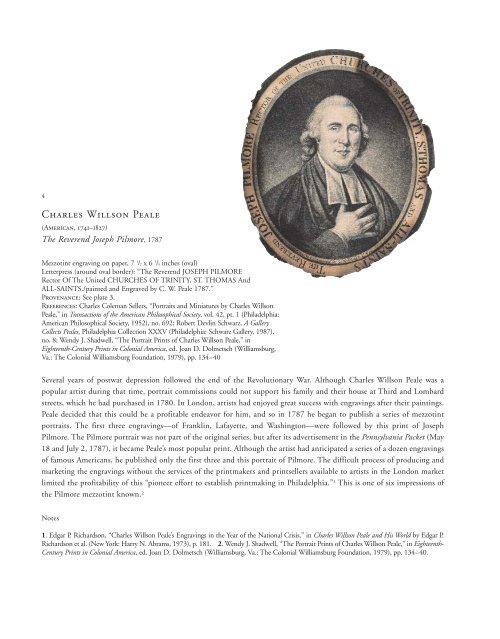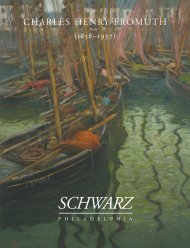pdf - Schwarz Gallery
pdf - Schwarz Gallery
pdf - Schwarz Gallery
You also want an ePaper? Increase the reach of your titles
YUMPU automatically turns print PDFs into web optimized ePapers that Google loves.
4<br />
Charles Willson Peale<br />
(American, 1741–1827)<br />
The Reverend Joseph Pilmore, 1787<br />
Mezzotint engraving on paper, 7 1 /2 x 6 1 /4 inches (oval)<br />
Letterpress (around oval border): “The Reverend JOSEPH PILMORE<br />
Rector Of The United CHURCHES OF TRINITY, ST. THOMAS And<br />
ALL-SAINTS./painted and Engraved by C. W. Peale 1787.”<br />
Provenance: See plate 3.<br />
References: Charles Coleman Sellers, “Portraits and Miniatures by Charles Willson<br />
Peale,” in Transactions of the American Philosophical Society, vol. 42, pt. 1 (Philadelphia:<br />
American Philosophical Society, 1952), no. 692; Robert Devlin <strong>Schwarz</strong>, A <strong>Gallery</strong><br />
Collects Peales, Philadelphia Collection XXXV (Philadelphia: <strong>Schwarz</strong> <strong>Gallery</strong>, 1987),<br />
no. 8; Wendy J. Shadwell, “The Portrait Prints of Charles Willson Peale,” in<br />
Eighteenth-Century Prints in Colonial America, ed. Joan D. Dolmetsch (Williamsburg,<br />
Va.: The Colonial Williamsburg Foundation, 1979), pp. 134–40<br />
Several years of postwar depression followed the end of the Revolutionary War. Although Charles Willson Peale was a<br />
popular artist during that time, portrait commissions could not support his family and their house at Third and Lombard<br />
streets, which he had purchased in 1780. In London, artists had enjoyed great success with engravings after their paintings.<br />
Peale decided that this could be a profitable endeavor for him, and so in 1787 he began to publish a series of mezzotint<br />
portraits. The first three engravings—of Franklin, Lafayette, and Washington—were followed by this print of Joseph<br />
Pilmore. The Pilmore portrait was not part of the original series, but after its advertisement in the Pennsylvania Packet (May<br />
18 and July 2, 1787), it became Peale’s most popular print. Although the artist had anticipated a series of a dozen engravings<br />
of famous Americans, he published only the first three and this portrait of Pilmore. The difficult process of producing and<br />
marketing the engravings without the services of the printmakers and printsellers available to artists in the London market<br />
limited the profitability of this “pioneer effort to establish printmaking in Philadelphia.” 1 This is one of six impressions of<br />
the Pilmore mezzotint known. 2<br />
Notes<br />
1. Edgar P. Richardson, “Charles Willson Peale’s Engravings in the Year of the National Crisis,” in Charles Willson Peale and His World by Edgar P.<br />
Richardson et al. (New York: Harry N. Abrams, 1973), p. 181. 2. Wendy J. Shadwell, “The Portrait Prints of Charles Willson Peale,” in Eighteenth-<br />
Century Prints in Colonial America, ed. Joan D. Dolmetsch (Williamsburg, Va.: The Colonial Williamsburg Foundation, 1979), pp. 134–40.



